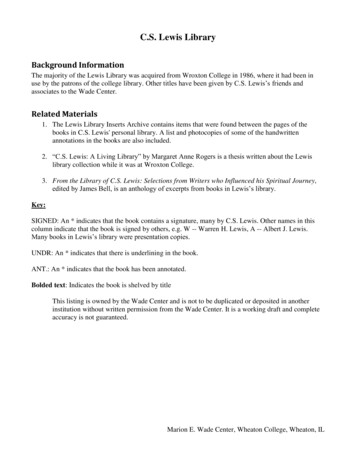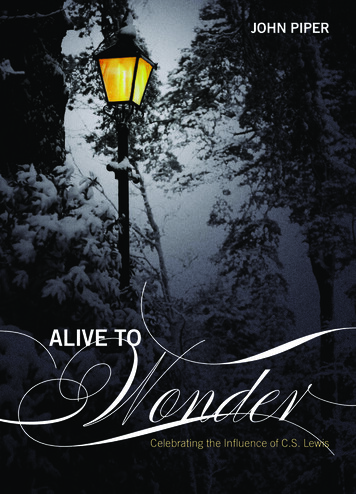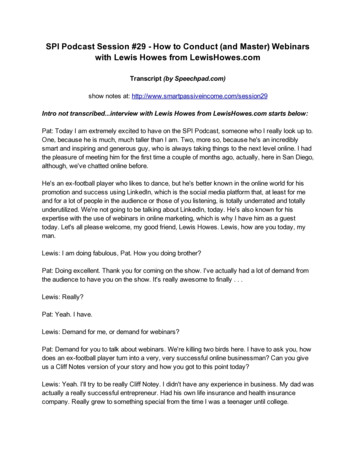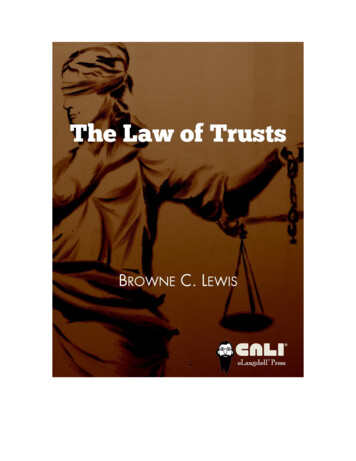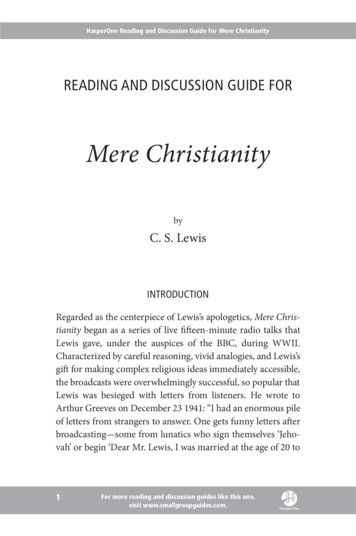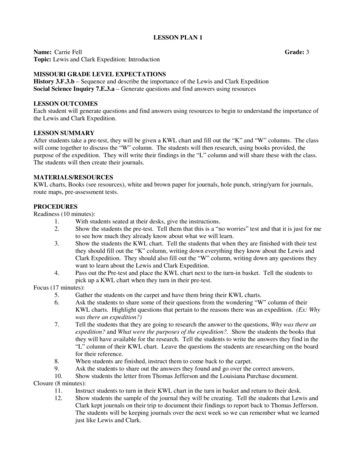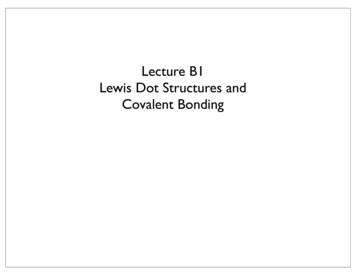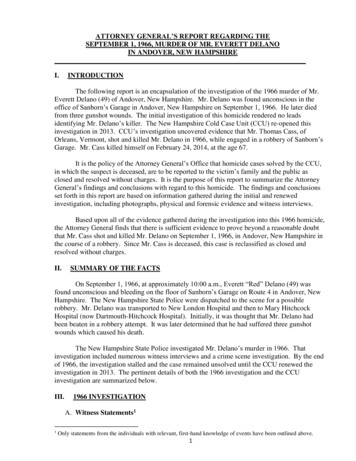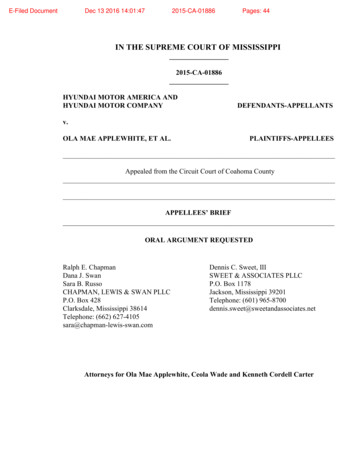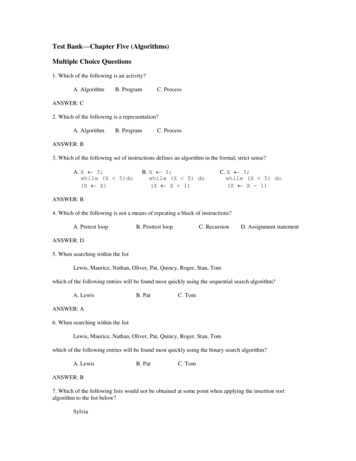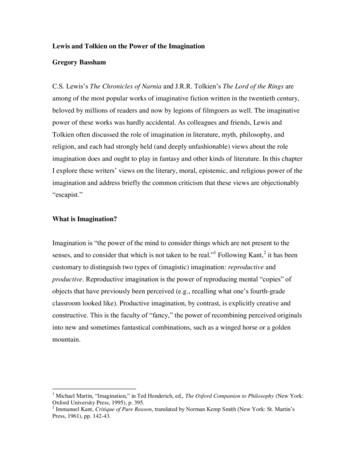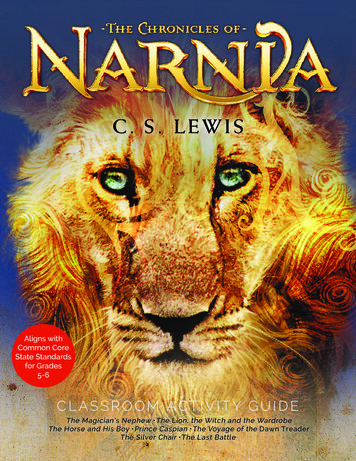
Transcription
C. S. LEWISAligns withCommon CoreState Standardsfor Grades5-6C l a s s r o o m Ac t i v i t y G u i d eThe Magician’s Nephew The Lion, the Witch and the WardrobeThe Horse and His Boy Prince Caspian The Voyage of the Dawn TreaderThe Silver Chair The Last Battle
C O N TE N TSAbout The Chronicles of Narnia . . . . . 3About C. S. Lewis . . . . . 3Reading Literature Skills . . . . . 4Themes . . . . . 4Discussions Across The Chronicles of Narnia . . . . . 4—5Independent Projects . . . . . 5Book 1: The Magician’s Nephew . . . . . 6Book 2: The Lion, The Witch and the Wardrobe . . . . . 7Book 3: The Horse and His Boy . . . . . 8Book 4: Prince Caspian . . . . . 9Book 5: The Voyage of the Dawn Treader . . . . . 10Book 6: The Silver Chair . . . . . 11Book 7: The Last Battle . . . . . 122w w w. h a r p e r c o l l i n s c h i l d r e n s . c o m
AB OUT THE C HRO NICLES OF NAR NIAMillions of children enjoyed Walt Disney Pictures and Walden Media’s incredible blockbuster motion pictures TheChronicles of Narnia: The Lion, the Witch and the Wardrobe,The Chronicles of Narnia: Prince Caspian, and The Chronicles ofNarnia: The Voyage of the Dawn Treader. Now is the perfect time to introduce the complete collection of C.S. Lewis’sseven classic novels to your students.Each book stands alone as a work of genius, but together they tell the entire history of a fantastic world of magic and adventure,a place in which the imagination knows no bounds. In The Chronicles, the world of Narnia becomes as real as our own.C. S. Lewis began piecing together the story of The Lion, the Witch and the Wardrobe long before it was published in 1950. Thetales and ancient myths his Irish nurse told him were his first inspirations for the creatures of Narnia. Then, when he wassixteen, a picture of a faun carrying parcels and an umbrella in snowy woods popped into his head.Years later, during WorldWar II, four children stayed with Lewis at his country house and stirred his imagination again. Not long afterward, he beganwriting the story that would become The Lion, the Witch and the Wardrobe.While writing, Lewis also incorporated his own memories, like the wardrobe from his childhood. As the children found theirway into Narnia, he was still unsure of what his story would be about. Then the image of Aslan came to him. Lewis once said,“I don’t know where the Lion came from or why he came. But once he was there, he pulled the whole story together.”After being illustrated by Pauline Baynes, The Lion, the Witch and the Wardrobe was published to great success. With so manystories to tell about Narnia and its unforgettable characters, Lewis wrote six more books. Published in 1956, The Last Battlewas awarded the Carnegie Medal—England’s highest honor for children’s literature.Millions of readers have discovered The Chronicles of Narnia. As you read the books for the first time, or rediscover theirmagic, take some time to discuss them. The following questions are intended to spark debate about topics such as good versusevil, symbolism, and relationships. So gather round and journey once more to the wondrous land of Narnia.Photo credit: Hulton Deutsch Collection/John ChillingworthAB OUT C . S . LEWIS (1 8 98 –1 963)Clive Staples Lewis, known as Jack to his friends, was born in 1898. Lewis and his good friendJ. R. R. Tolkien, the author of the Lord of the Rings trilogy, were part of the Inklings, aninformal writers’ club that met at a local pub to discuss story ideas. Lewis’s fascination withfairy tales, myths, and ancient legends, coupled with inspiration drawn from his childhood,led him to write The Lion, theWitch and theWardrobe, one of the best-loved books of all time.Six futher books followed to become the immensely popular Chronicles of Narnia. Thefinal title in the series, The Last Battle, won the Carnegie Medal, one of the highest marks ofexcellence in children’s literature.w w w. n a r n i a . c o m3
SHARI N G THE C HRONICLES OF NARNIAREADING LITERATURE SKILLSU n d e r s ta n d i n g Fa n ta s yFantasy has long been a favorite genre for readers of all ages. It ischaracterized by unrealistic elements such as characters with magical powers, talking animals, mythical beings, and a setting, oftenmedieval, of a new or different world. Any event that happens ina fantasy is an occurrence that cannot be explained scientifically—nor could it ever occur. A tree, for instance, will never be ableto uproot itself and walk; however, can a virus possibly destroy acountry’s population? Can there be life on another planet? Theselatter two questions are possible and are characteristic of sciencefiction, a genre often confused with fantasy.As students read the books in this series, have them identify anddiscuss motifs commonly found in fantasy, such as wizards, sorcerers, witches, mirrors, dragons, and spells. What characteristics offantasy are most prominent in this series?A n a ly z e S t r u c t u r eHave students determine the meaning of words and phrases asthey are used in the series and examine how the author uses digressions, stories within stories, flashbacks, and shifts in point ofview to get across information and keep the story moving. Whatrole does suspense play in these stories? How is it created andsustained? Students should be aware that part of an author’s art isdeciding what to leave out. Watch for what Lewis tells us he isn’ttelling us!Examine Voice and ViewpointAsk students to consider the following questions: Who is the narrator of The Chronicles of Narnia? What words would studentsuse to describe the narrator’s voice? How does the author usehumor and irony to entertain the reader, and what effect do thesehave on the story? Ask students to take special note of asides tothe audience, places where the narrator breaks the story to talkdirectly to the reader. What do these moments add to the story?Have students discuss how point of view influences how the storyand/or events are told.I n v e s t i g at e C h a r a c t e rHave students analyze the characters they encounter in TheChronicles of Narnia. They may consider their traits, motivations,conflicts, points of view, and relationships, and the changes theyundergo. How is Lewis able to establish character with a fewcarefully chosen details? Can we tell what a character will do ina given situation based on what we know about him or her?When do characters change, and why? How do recurringcharacters evolve over the course of The Chronicles of Narnia?Ask students to compare and contrast two or more characters.R e co g n i z e L i t e ra ry D e v i c esLewis’s lively writing provides repeated opportunities to identifywordplay, analogies, similes, metaphors, allegories, and symbolism.Ask students to be aware of how different characters use language.How do these devices enrich the text?4THEMESLewis’s work is rich with literary themes. Four themes you maywish to explore with your students include:G o o d a n d Ev i lCharacters regularly confront issues of good and evil. Have students identify any character and, using evidence from the text,explain how that character’s beliefs affect how he or she acts andvice versa. Identify examples of good and evil behavior. How doesthe character respond to good and evil?CourageHave students define “courage” and then identify situations in theseries when characters express courage. Using evidence from theseries, have students examine the difference between rash actionand courageous action. What is the difference between cautionand cowardice? How does fear affect how the characters perceivethe world and how they act?FriendshipAsk students to discuss characteristics of a good friend and thendiscuss the friendship, or lack thereof, between any two charactersin the series. How does this relationship grow and change overtime? What accounts for the changes?TrustThroughout the series, characters must make decisions based ontheir ability to trust or not trust other characters. Have studentsexamine the concept of trust and discuss how it evolves throughout the series.English Language Arts Common Core ReadingLiterature Standards: RL.5.3, RL.5.4, RL.5.5,RL.5.6, RL.6.3, RL.6.4, RL.6.5, RL.6.6.D I S C U S S I O N S A C RO S ST H E C H RO N I C L E S O F N A R N I AThe following questions are designed to spark discussion aboutthe issues and topics raised in this series and to provide studentsopportunities to develop speaking and listening skills.C h i l d h o o d a n d A d u lt h o o d“Children have one kind of silliness, as you know, and grown-upshave another kind” (The Magician’s Nephew, p. 89). How wouldyou describe the difference between these kinds of silliness? Whatare some other observations the author makes about children andadults? Do you think Lewis remembered his own childhood orhad a sense of how children think? Why or why not? With a partner, identify two to three additional observations about the differences between children and adults that are present in the books.Share your observations with the class.Complexity of EmotionLewis frequently shows characters feeling more than one thingat once or experiencing alternating emotions. Find examples ofw w w. h a r p e r c o l l i n s c h i l d r e n s . c o m
SHARI N G THE C HRONICLES OF NARNIA(co nt i n u e d )characters dealing with conflicting emotions in the books andsee if you can explain the characters’ experience in small groups.Choose one idea to share with the class as a whole.Gender RolesCompare male and female roles in the books. Discuss how TheChronicles of Narnia reflect different expectations for boys andgirls. How do attitudes about gender roles at the time the serieswas written (early to mid-1950s) compare with attitudes now?What changes might you see in gender roles if the story had beenwritten in 2013?Recurring CharactersDescribe your favorite character(s) using three to four adjectives.What events, descriptive passages, or dialogue support your description? Why do you think the author decides to send particularcharacters—and not others—on each specific voyage?Ta l k i n g a n d N o n -Ta l k i n g A n i m a l sWhat distinction is made between talking animals and nontalking animals? Why do Narnians consider it horrible to kill oreat a talking animal when it is okay to kill or eat a non-talkingone? What does this belief say about the importance of speech tothe author or as an attribute of humanity? Use evidence from thebooks to support your discussion. Summarize one point discussedby a classmate and explain how the books either support or do notsupport that person’s claim or argument.English Language Arts Common Core Speakingand Listening Standards: SL.5.1, SL.5.3, SL.6.1, SL.6.3.I N D E P E N D E N T P RO J E C T SYou may not have time to read all of The Chronicles of Narnia withyour class. If not, you might want to encourage students to continue reading the books on their own. Following are suggestions forindependent projects for your students who read the whole series:Keep a JournalStudents can keep journals to record their responses to TheChronicles of Narnia as they read. You might ask students to usetheir journals to do any or all of the following: Pause at points when characters face a difficult decision and askthemselves: What would I do in this situation? Choose a character who speaks in a distinct style and write aparagraph in that character’s voice. Choose a character whose point of view is not shown in a particular section and tell the section’s story from that character’spoint of view. Record questions you would like to ask the author or characters. Note literary devices; keep lists of new vocabulary words. Write down quotations you find interesting and might like todiscuss later. In particular, you could note observations that youthink apply to our world. Sketch drawings inspired by mental images the text evokes.C r e at e a Va l u e s C h a r tMake a chart with two columns, “Values” and “Characters.” In thefirst column list the following values represented in The Chronicles ofNarnia: charity, faith, humility, justice, mercy. In the second columnlist the characters in whom you see these values embodied.Make a Narnia MapCreate a map of the world of Narnia, showing its physical features,towns, and other places of interest.You may want to include drawings of some of the characters and events.Make a Narnian Time lineNarnian time moves differently from ours, and readers learn alittle more about this in each book. Make two parallel time linesshowing how much time has passed between the books—inNarnia and in England.Research Historical ConnectionsThe Chronicles of Narnia were written in the years followingthe cataclysmic events of World War II. In fact, the first Narniabook—The Lion, the Witch and the Wardrobe—takes place whilebombs are falling on London. Research why the Allies’ defeat ofthe Nazis has been viewed as the triumph of good over evil. Thenwrite a report describing how the historical events of World WarII may have played a role in The Chronicles of Narnia, especiallyin the ongoing struggle between Narnia and Calormen.W r i t e a C h a r a c t e r S t u dyChoose two characters who appear in several books.Write a character study of each describing how he or she grows and developsfrom one book to the next. Students may wish to brainstorm ideasfor their writing by first creating a character map.Write a Descriptive PoemFrom its creation in The Magician’s Nephew to its destruction inThe Last Battle, the world of Narnia is revealed in increasingly detailed layers. Write a poem evoking the physical world of Narnia.W r i t e a Fa n ta s yC. S. Lewis used the fantasy genre to create a world in which characters must regularly confront issues of good and evil, right andwrong. Write your own fantasy. Create a world based wholly onyour own imagination, filled with fanciful creatures facing conflicts that test their morality.Write an InterviewSuppose you could interview C. S. Lewis. Write questions aboutthe books and then, based on your reading of The Chronicles ofNarnia, the answers you think he would give.English Language Arts Common Core Writing Standards:W.5.1, W.5.2, W.5.3, W.5.7, W.6.1, W.6.2, W.6.3, W.6.7.w w w. n a r n i a . c o m5
BOOK 1THE MAGICIAN’S NEPHEWWhere does the Wardrobe come from . . . and how was Narnia born?SETTING THE SCENEDigory’s uncle Andrew has used dust from another world tofashion magic rings that he himself is afraid to use to exploreother worlds. But when Digory and his new friend Polly stumble into Uncle Andrew’s attic, the magician is not afraid to trythe rings on the children! Digory and Polly are then drawn intoworlds beyond our own, where they find many unexpected adventures. When Digory’s action in one world awakens a Witchfrom a spell, the children’s travel between the worlds takes on anew urgency: to stop the Witch in her quest for power.Q U ESTIONS F OR GRO U P DISC U SSION What are some of the different ways Lewis allows us to discoverthe characters? For example, what do we learn from how theyappear, how they act and react, what they say, and how theycontrast with one another? Use specific details from the text tosupport your answers. How does Lewis create a sense of place as the characters arrivein new worlds? Through whose point of view are new placesdescribed? How does point of view influence how these placesare described? What is the Wood Between the Worlds? What effect does ithave on Polly and Digory? On the Witch and Uncle Andrew?Why? What does the Wood symbolize? Use details from thestory to support your responses. One of the first experiences that enters Narnia after Aslansings it to life is laughter. What effect does the author createby establishing Narnia with a joke? Why does Aslan send Digory for the apple when he couldeasily make it appear? What details from the text supportyour answer? What attributes does Cabby possess as the first King of Narniathat make him a good ruler?6Q U OTESDiscuss the following quotations. What do they mean in context?How does each contribute to character development? “Men like me, who possess hidden wisdom, are freed fromcommon rules just as we are cut off from common pleasures.Ours, my boy, is a high and lonely destiny.” (Uncle Andrew,p. 21) “Things always work according to their nature. She has won herheart’s desire; she has unwearying strength and endless days likea goddess. But length of days with an evil heart is only lengthof misery and already she begins to know it. All get what theywant; they do not always like it.” (Aslan, p. 208)J O U RNAL WRITING : S e n s o r y I m a g e s“But it was a different kind of quietness. The silence of the Woodhad been rich and warm (you could almost hear the trees growing) and full of life: this was a dead, cold, empty silence.” (p. 48)Listen for a quiet moment. Then describe the quiet.WRITING EXPOSITORY TEXTS : S e t t i n gWrite a paragraph or essay describing the setting of the story. First,brainstorm descriptive words that come to mind and skim thebook for particularly compelling phrases. Use two or three phrasesfrom the book in your description, as well as words you brainstorm. List the page numbers where you found the phrases inparentheses at the end of each paragraph or sentence.English Language Arts Common Core Standards:RL.5.1, RL.5.2, RL.5.3, SL.5.1, W.5.1, W.5.2, RL.6.1,RL.5.2, RL.6.3, SL.6.1, W.6.1, W.6.2.w w w. h a r p e r c o l l i n s c h i l d r e n s . c o m
BOOK 2THE LION, THE WITCH ANDTHE WARDROBENow aMajor MotionPicture!Step through the wardrobe and into Narnia.SETTING THE SCENEFour siblings journey from London during World War II to stayat an unusual home in the English countryside. Through a forgotten wardrobe filled with musty coats, the children find theenchanted land of Narnia. A secret world of magic and danger,Narnia is ruthlessly ruled by the White Witch, who has cast theland into an eternal winter. Only the return of the Great Lion,Aslan, can break the Witch’s evil spell. And a rumor is spreading:Aslan is on his way back. It is at this turbulent moment that thefour children stumble through the wardrobe and find themselvescenter stage in the battle for control of Narnia.Q U ESTIONS F OR GRO U P DISC U SSION What are some individual character traits of each of the fourchildren: Peter, Susan, Edmund, and Lucy? How do they changeover the course of the story? Compare and contrast any twocharacters. Compare and contrast the characters of the Lion and the Witch(for example, what kinds of power they have, how they exercisepower, how they interact, how they respond to events). Courage is a theme in the book. Describe how the authordevelops this theme over time. Identify an additional themein the book and explain how the author introduces it andhow he develops it throughout the story. Why does Edmund lie about having been to Narnia? Howdoes lying affect him? How does it change his relationshipwith other characters? In what ways is the Professor an unusual grown-up? Describehis “logic” (see p. 52). What inferences can you make about hischaracter? How does Edmund justify his choice to go to the White Witch?How is his decision viewed by other characters? What advice does the Professor give the children at the end ofthe book? What message might the author be sending to thereader? What evidence from the text supports this message?EXPLORE LANG U AGEThe Lion, the Witch and the Wardrobe is written in a friendly,informal voice, in the idiom of 1940s Britain. Therefore, occasional words and phrases may be unfamiliar to American students.Examples in the first chapter include the words “wardrobe”(closet where clothes are kept), “wireless” (radio, p. 4), and “looking-glass” (mirror, p. 5). As students read, ask them to write downwords and expressions that seem to come from a different timeor place. Then have them work in small groups to discuss whatthese expressions mean and to create a two-column “translation”chart in which they include definitions in familiar “American”English.Lewis is wonderful at creating analogies, at helping readers understand something they don’t know by comparing it to somethingthey might know. Examples include the long description of theride on the Lion’s back (p. 180) and of the statues coming tolife again (pp. 184–5). Challenge students to think of somethingthey have done or seen that others may not have experienced.Then have volunteers try to come up with a way to describe thisto someone by comparing it to something that would be morefamiliar to him or her.J O U RNAL WRITING : W r i t e a Fa n t a s yImagine you slipped through a secret passage into another world.Make up a fantasy about meeting someone there. Write aboutwhat happens and how you get back.WRITING EXPOSITORY TEXTS : S e t t i n gHave students identify a theme in the story and write an essay inwhich they explain how the theme is introduced and developedover time.English Language Arts Common Core Standards:RL.5.1, RL.5.2, RL.5.3, RL.5.4, SL.5.1, W.5.2, W.5.3, RL.6.1,RL.6.2, RL.6.3, RL.6.4, SL.6.1, W.6.2, W.6.3.w w w. n a r n i a . c o m7
BOOK 3THE HORSE AND HIS BOYWhat happened in Narnia after the White Witch was defeated?SETTING THE SCENEA boy named Shasta and a talking horse named Bree—separatelycaptured in youth and enslaved in Calormen—together attemptto make their escape to Narnia, a land the horse dimly recallsand the boy does not know at all. Soon they meet another pairof fugitives: a Calormene girl named Aravis, escaping an arrangedmarriage, and the talking horse Hwin. Their escape route takesthem through the wondrous city of Tashbaan, where they findthemselves in the midst of a larger adventure. It falls to them tosave the lands to the north—Archenland and Narnia—from a surprise attack by the Calormenes. In the process, Shasta learns whohe really is and even finds his real father.Q U ESTIONS F OR GRO U P DISC U SSION Why does Bree decide to talk to Shasta after years of hiding thefact that he is a talking horse? What mistakes do Shasta and Aravis make about each other andwhy? How do their perceptions of each other evolve over thecourse of the story? Compare and contrast the ways in which two or more characters show pride. How do their approaches help them? How dothey hurt them? Why is the book called The Horse and His Boy rather than ABoy and His Horse? Find places in the text where Shasta appearsto be Bree’s boy. What information is explicitly stated? Whatinformation is inferred? What kind of leader is the Tisroc? What details support youranswer? Why does he agree to Prince Rabadash’s plan? What role does Aslan play in the story? Identify several wordsused to describe him. How is he able to be such different thingsat the same time? How do people react after they see Aslan?Why does Aslan tear Aravis’s back? Why does Lewis narrate the battle at Anvard through the Hermit’s reflecting pool rather than at the scene or through Shasta’sperspective? What tone does this lend the battle? How wouldthe battle be different if it were described by Shasta? Is Prince Rabadash’s punishment appropriate? Why or whynot? What emotions does Prince Rabadash evoke in readers,and what words does Lewis use to evoke those emotions?8Q U OTESDiscuss the following quotations. What do they mean in context?What themes do these passages convey, and how does the authordevelop these themes throughout the story? “These little barbarian countries that call themselves free (whichis as much to say, idle, disordered, and unprofitable) are hateful tothe gods and to all persons of discernment.” (the Tisroc, p. 120) “But as long as you know you’re nobody very special, you’ll bea very decent sort of Horse, on the whole . . .” (the Hermit, pp.161–2)J O U RNAL WRITING : L a n g u a g ePeople have different ways of speaking in this book, depending onwhere they are from and what their position is in society. Choosea character and “translate” what he or she is saying into your ownwords or into language another character might use.WRITING EXPOSITORY TEXTS : E x p l i c a t i n ga PassageChoose a meaningful passage and write a paragraph explainingthe meaning of the passage. What does the passage mean in context? What additional meaning outside the story might the passagehave?English Language Arts Common Core Standards:RL.5.1, RL.5.2, RL.5.3, RL.5.4, RL.5.5, SL.5.1,W.5.2, W.5.3, RL.6.1, RL.6.2, RL.6.3, RL.6.4,RL.6.5, SL.6.1, W.6.2, W.6.3.w w w. h a r p e r c o l l i n s c h i l d r e n s . c o m
BOOK 4PRINCE CASPIANNow aMajor MotionPicture!Peter, Susan, Edmund, and Lucy return to Narnia!SETTING THE SCENEIn a dreary train station in England on their way back to boardingschool, Peter, Susan, Edmund, and Lucy suddenly feel themselvesbeing tugged into another world. They arrive on an unknownisland, where they find the ancient ruins of a palace. But something feels familiar about this place. Eventually the children recognize that they are at Cair Paravel, where they themselves ruled asQueens and Kings of Narnia. They discover that they have beencalled back to Narnia because the forces of Old Narnia are introuble. Just one year has passed in our world, but hundreds ofyears have passed in Narnia. The rightful king, Prince Caspian, isfighting a war against his uncle, King Miraz, who wants to destroythe country of Aslan—the Talking Beasts and trees, the Dwarfs andFauns—and all memory of Old Narnia. In desperation, Caspian’sforces have blown a magical horn—the very horn Susan once received from Aslan—to summon the Lion and the children to helpthem in their struggle.Q U ESTIONS F OR GRO U P DISC U SSION Once more we meet Peter, Susan, Edmund, and Lucy. Inwhat ways have they stayed the same? In what ways have theychanged? How have their previous adventures shaped them?How do they behave differently as children and then as Kingsand Queens of Narnia? Base your answers on explicit evidenceand inferences you can draw from the story. Compare and contrast Nikabrik and Trufflehunter.What different points of view do they represent? How would the story bedifferent if Nikabrik or Trufflehunter did not exist? Why doesthe author need both characters? Use specific details in the textto support your answers. “But because they have quarreled with the trees they are afraidof the woods. And because they are afraid of the woods theyimagine that they are full of ghosts” (Doctor Cornelius, p. 56).What observation about fear does this passage reflect? Why isKing Miraz afraid of the stories of Old Narnia? Is his fear justified? Support your response with evidence from the text. Howdoes the author develop the theme of fear? What details doesthe author use to develop this theme? How does faith or lack of faith guide the actions of charactersin this book? How does Susan feel when she does not followAslan? What does Aslan mean by telling her she has “listened tofears” (p. 162)? What is the author’s view of faith? What detailsin the story support this view? How does Peter face the possibility that he might be killed byMiraz? What is the narrator’s attitude toward Peter’s possibledeath? What words or phrases support the author’s attitude? In what way does Aslan test Caspian about his suitability to beKing? How does Caspian pass the test? How does Reepicheep earn his tail back? Does he deserve towin it back? Why or why not? How does Reepicheep changeas the plot unfolds?Q U OTESDiscuss the following quotations. What do they mean in context?What do they illustrate about each speaker? “I’ll believe in anyone or anything . . . that’ll batter these cursedTelmarine barbarians to pieces or drive them out of Narnia.Anyone or anything, Aslan or the White Witch, do you understand?” (Nikabrik, p. 80) “Wouldn’t it be dreadful if some day in our own world, athome, men started going wild inside, like the animals here, andstill looked like men, so that you’d never know which werewhich?” (Lucy, p. 128)J O U RNAL WRITING : M e n t a l I m a g e sReread Lucy’s thoughts on pages 122–3 about the trees coming tolife. If a tree you have seen could come to life, what do you thinkit would be like? How would it move? How would it speak? Whatwould it do? Write or draw your answer.WRITING EXPOSITORY TEXTS : I m a g e r yChoose a particularly compelling scene and write a paragraph oressay explaining how the author uses specific words to make thescene vivid.English Language Arts Common Core Standards:RL.5.1, RL.5.2, RL.5.3, RL.5.4, RL.5.5, SL.5.1,W.5.2, W.5.3, RL.6.1, RL.6.2, RL.6.3, RL.6.4,RL.6.5, SL.6.1, W.6.2, W.6.3.w w w. n a r n i a . c o m9
BOOK 5THE VOYAGE OF THEDAWN TREADERNow aMajor MotionPicture!Sail to the end of the World with Lucy and Edmund.SETTING THE SCENEEustace Clarence Scrubb complains a lot. He also makes fun ofthe Narnia stories he hears his cousins Lucy and Edmund discussing. His point of view changes, however, when the three childrenare suddenly drawn up into a painting of a ship and find themselves swimming in the cold ocean waters off Narnia. There theyare rescued by Prince Caspian and the crew of the Dawn Treader,who are on a mission to find the seven good lords banished fromNarnia by the former King, Miraz. Meeting adventures at everyisland, the Dawn Treader travels beyond known lands, urged on byPrince Caspian’s vow to find his father’s friends and by the mouseReepicheep, who longs to sail all the way into Aslan’s country atthe End of the World.Q U ESTIONS F OR GRO U P DISC U SSION Who is Eustace Clarence Scrubb? Choose a fact or story aboutEustace and explain what it tells us about him. How does hechange as a result of his experiences on (and off) the DawnTreader? Why is Reepicheep so concerned with honor? How does theauthor develop this sense of honor throughout the story? Usingevidence from the story, explain how Reepicheep’s size and thefact that he is a mouse affect his behavior. Describe some contradictions in his personality. What does he do that’s surprising?Why does he long to sail to the En
aBout C. s. lewis (1898–1963) Clive Staples Lewis, known as Jack to his friends, was born in 1898. Lewis and his good friend J. R. R. Tolkien, the author of the Lord of the Rings trilogy, were p
